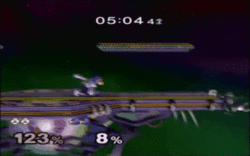Spacing: Difference between revisions
(Rewritten to sound less like a guide; will likely need further cleanup and/or expansion.) |
(The previous content described spacing at far too low of a level. This will do for now but I plan to elaborate on advanced spacing when I have time.) |
||
| Line 1: | Line 1: | ||
{{ArticleIcons|series=y}} | {{ArticleIcons|series=y}} | ||
{{cleanup| | {{cleanup|Needs elaboration on advanced spacing and more gifs to demonstrate precise interactions}} | ||
'''Spacing''' | [[File:Spacing.gif|thumb|250px|Zhu using Falco's aerial drift to space around Mew2king's shield grab.]] | ||
'''Spacing''' describes both a player's awareness of an opponent's options and said player's ability to avoid and counter them. At its simplest form, spacing tests knowledge of 2 things: how character can move before, during, and after an action, and the periods of vulnerability and invulnerability of the action. Every action in game has a certain timing and area of effect; to "space around" said action means to use knowledge of both its timing and range to pick another action whose own timing and range beat those of the original action. Spacing is by far the most important skill tested in competitive smash as every single interaction between 2 players is decided by who picked the better timing and position in an exchange of actions. | |||
At the lowest level of competitive play, spacing only involves superficial comparison of the hitbox ranges of attacks with very little nuanced timing due to lack of tech skill and knowledge of positioning. At this level of play, the most successful characters tend to be characters with long raw hitbox range like [[Marth]] or characters with fast attacks [[Sheik]]. As the level of play increases, players first reach a level of tech skill where they are able to extrapolate how hitboxes can move relative to their character's movement. At this level of play, players are able move in and out of attack ranges, albeit fairly imprecisely, with simple movement options like [[wavedashing]] and [dash dancing]]. At the highest level of play, players have internalized the knowledge of their character's movement and attacks to where they can move around attacks at very precise distances; the example at the beginning of the page demonstrates very precise awareness of the range and timing of Sheik's shield grab. | |||
==External links== | ==External links== | ||
Revision as of 01:39, October 16, 2017
Spacing describes both a player's awareness of an opponent's options and said player's ability to avoid and counter them. At its simplest form, spacing tests knowledge of 2 things: how character can move before, during, and after an action, and the periods of vulnerability and invulnerability of the action. Every action in game has a certain timing and area of effect; to "space around" said action means to use knowledge of both its timing and range to pick another action whose own timing and range beat those of the original action. Spacing is by far the most important skill tested in competitive smash as every single interaction between 2 players is decided by who picked the better timing and position in an exchange of actions.
At the lowest level of competitive play, spacing only involves superficial comparison of the hitbox ranges of attacks with very little nuanced timing due to lack of tech skill and knowledge of positioning. At this level of play, the most successful characters tend to be characters with long raw hitbox range like Marth or characters with fast attacks Sheik. As the level of play increases, players first reach a level of tech skill where they are able to extrapolate how hitboxes can move relative to their character's movement. At this level of play, players are able move in and out of attack ranges, albeit fairly imprecisely, with simple movement options like wavedashing and [dash dancing]]. At the highest level of play, players have internalized the knowledge of their character's movement and attacks to where they can move around attacks at very precise distances; the example at the beginning of the page demonstrates very precise awareness of the range and timing of Sheik's shield grab.

